- Home Page
- Rooms Reservation
- Internal pictures
- Benefits
- Itineraries
- FAQ
- Our guests book
- Prices
- How to reach us


Dear visitors,
here I tell you about Soave, one of the most famous medieval boroughs in the close environs of our farm-holiday structure. Known all over the world for the excellence of its grapes and wines, and classified as ORANGE BOROUGH TOURING CLUB, Soave is surely placeable in our favourite villages list.
A trip to Soave is always the first itinerary that I advise to my guests during their stay here at the Farm. The medieval borough is only 3 km far from us and it is a real historical jewel, full of known treasures, and even many others, less known, that you could visit and enjoy, like churches, monuments, museums, palaces but also wine-bars and typical restaurants.
The thing that definitely enchants more our visitors is the huge and massive mole of our Castello Scaligero, that twists and turns its beautiful structure from the top of the hill, down to the base of it, following its slopes.
It's like a beautiful painting full of poetry in every season: the greens, the yellows and the ochers of the earth and the vineyard, lined in perfect rows, are simply magic. And itis exactly this wonderful magic, that I'm going to show you, telling you about Soave in this short and simple text which is a kind of tale.
WHERE IS SOAVE AND HOW TO REACH SOAVE
To reach Soave from our Farm-holiday "I COSTANTI", you have to reach the SR11 Verona-Vicenza and go straight on the way to Vicenza, until you get to the last roundabout at the left side of which you have the entrance to the motorway A4 Milan-Venice. Once you get over the overpass you'll be right in front of Soave's borough and of Porta Verona. You can park in the little Foro Boario square, where is also situated the IAT local center (the tourist information office). The staff offers a great reception and information service.
If you'd like to drink an aperitive or enjoy a good glass of the famous white wine Soave you just need to walk through Via Roma, and, going in direction of Piazza Antenna, you'll be able to see a lot of wonderful wine-bars and selling points (just like the Coffele) where it is possible to have some tastings and buy the wine that you prefer.
Just outside the walls, if you're looking for the typical venetian "grandma's cooking" in a warm and familiar location, on your right you'll find the tavern Dal Moro (remember to say that you're my guests!). I also advise you to try the wonderful Osteria La Scala, inside the borough, behind the walls, just nearby another good restaurant, IL GAMBERO. If you want to book a table you'd better call with a certain advance because they are often very busy.
WHERE IS SOAVE LOCATED?
Soave is situated in the East of Verona, precisely in the Val Tramigna, side by side with the other valleys of Illasi and d'Alpone.
Professor Rama, who's been writing a lot about Soave giving me the most of my knowledge about it, tells us that this land could have got its name from its "intra-moenia" geographic location, that means in the middle between the two castles, the Illasi's and the Soave's ones. Val Tramigna could also mean "terminal valley".
Soave is crossed by the Tramigna river, which passes just nearby its walls, going then to flow in the bigger Alpone, not even too far from Villanova in San Bonifacio, a little hamlet famous fort the beautiful romanesque abbey, definitely to be seen.
A BIT OF HISTORY ABOUT SOAVE, WONDERFUL LITTLE WALLED TOWN IN VENETO
Soave is located about 20 km far from Verona and only 3 km from our Caldiero, another little country in the East side of Verona, where our farm holiday is situated. Its happy geographic position in the Po valley (Pianura Padana) and the fertility of its fields, are, without any doubt, essential factors for its economic success and its fame in the whole Veneto and in a quite big part of the world.
Sure historical sources say that the name "Soave" could derive from "svevo": some ancient swedish people could have decided to place themselves around here, more or less in the sixth century A.C., during the langobardic invasions. We, anyway, have to remember that, before this, Soave was abode of a little ancient roman village placed on the Postumia, and the most ancient part of it seems to be the "Bassanella" just out of Porta Bassano.
The stronghold (The Castle of Soave) seems to date back to the 9th century, about 300 years before the Scala Signory, the dinasty who everybody refers to talking about Soave's Castle. From a Federico Barbarossa's diploma, we can infer that the first feudatories were the Sambonifacio who owned the territory until the first years of the 3rd century.
After them the property passed to Ezzelino da Romano, then to the Greppi
Lord family (about 1237), and in the end, after the many tries of the
Sambonifacio to get it back, to Mastino I della Scala. After him,
Cansignorio della Scala decided to rise the castle walls, giving it the
strong and huge outlook that we can see today.
Always more or less in the years that followed the 300 a.C., Palazzo di
Giustizia and Palazzo del Capitano were also built.
A more poetical version about the birth of the name "Soave" refers to the feeling of calm and sweetness that the nice weather infuse, the morphology of the fields, and the familiar nature of the locals.
After the Scala dinasty Soave was held by the Visconti, then the Carrarians and later by the Venetians of the Serenissima, who gave it a healthier historical period. It was in those years, that the outside garden was built and the castle was expanded. New palaces were built.
In 1500, the soldiers of Massimiliano d'Amburgo assaulted the castle and killed many citizens, before it was recaptured by the Venetians. To remember and reward the loyalty that many citizens had shown to the Serenissima, Venice donated to Soave the Antenna and the Standard representing the San Marco Lion, to be lifted up in Piazza Antenna during every local celebration, the same one that we can admire today during the country civil parties. After the plague epidemics happened in 1630 and in 1677 the castle became a property of the Gritti family that turned it into a farm. After the decline of the power of the Republic of Venice, Soave was controlled by the Austrians and then, in 1866 Soave gets into the Regno d'Itali; just a few years later, in 1871, it became seat of the Judiciary District. Six years later, Senator Camuzzoni inheried it and operated an accurate restoration with love and passion. In 1930 the "Cantina Sociale di Soave" was opened and started to be productive.
A VISIT TO THE CASTLE OF SOAVE
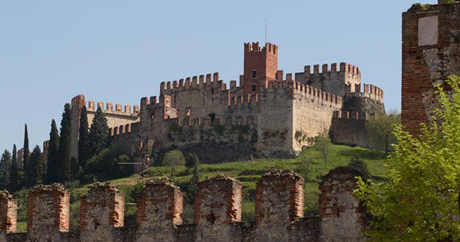
The "Castello Scaligero" is one of the most well-preserved palaces that I know in Veneto. It's possible to get a glimpse of its beautiful architecture, which at first sight already tempts you to visit it, from the freeway, in the direction of Verona. You can reach it walking from the Soave centre, starting from Piazza Antenna or, otherwise, by car, driving from the Bassanella. It is possible to access by the North-side walking on a lift bridge which introduces us to a main defensive tower with a sculpture of San Giorgio on the top.
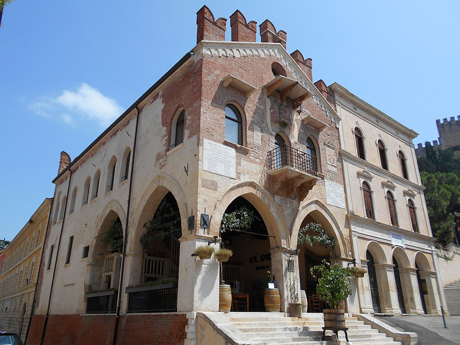
Piazza Antenna
The first garden that we reach is the one built by the Venetians as a military refuge, then, proceeding through and through discovering the castle, we find the second one, which shows on the top of its door a wonderful fresco with the Protecting Virgin dating back to the 14th century. There's also a 3rd garden where we can see another fresco (same age of the other one) depicting the Scala (stair) symbol of the Scaligeri Dinasty, rampant dogs and soldiers under the "Scala" motto; in the middle of the third garden dominates a beautiful ribbed pit, and over a huge stone bastion it is possible to see the great Mastio Tower. From an entrance at the base of the tower you access to a dark place, an ancient torture basement where a lot of human bones were found. Then, another part of the castle that I suggest you to see is the "Corpo di Guardia", another building with a cross vaults ceiling were are still conserved offensive and defensive weapons, just like crossbows, halberd, sward, helms, and mallets.
The outside stairs drive you the amazing Prince's domicile. Its living room is now used as a little museum of romanesque evidences and many other medieval objects. In the bedroom, an amazing decoration acts as wallpaper and on another wall, we can see a fresco depicting a Christ on the Cross between Mary and Magdalene. On the opposite side we find the great lunchroom, where staff are placed to reproduce a typical table of that age, nearby a little room, containing the portraits of Mastino I, Cangrande, Dante, Cansignorio, and Taddea della Scale, Mastino II's wife. Passing through a little door we can get to the ancient patrol routes and to the other fortified tower, where we can enjoy a beautiful sight of the land around, the Pianura Padana and the Lessinia Mountains. That's the reason why I advise a visit to the castle in every season, this sight is wonderful to see in summer, just like in spring and in autumn, but also in winter; in these last two seasons a visit is suggested in the morning.
The walls that surround the borough create a four side structure with towers showing guelphic and gibelline merlons, and three doors: Porta Verona, Porta Vicentina and Porta Bassano respectively placed on the south, east and north sides. Porta Bassano drives you to Castlecerino, Fittą and Coateggiola, the Vicentina gets you on the way to Monteforte, but it's quite never used, and Porta Verona is the one which acts like entrance from different directions, definitely the main one.
PALACES, MONUMENTS AND CHURCHES IN SOAVE
Soave is a wonderful place, known for its wine, sights and history. In Soave often Time seem to have stopped for a while, and walking through the little streets and alleys of the historical centre, we just feel like being brought back in time right to the Middle Age.
THE MONUMENTS INSIDE THE BOROUGH
Walking through Soave's historical centre and walking Via Roma in direction of Piazza Antenna, on our right we can see Piazza Mercato dei Grani, which, in those years, was used as a place to trade wheat and cereals. An ancient Jewish community, running away from Verona, found here a way to well integrate itself in the local society.
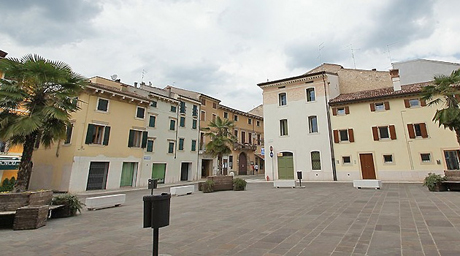
Piazza Mercato dei Grani
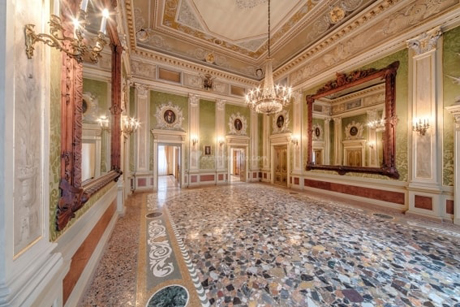
Palazzo Conti Sambonifacio
Keeping on going through Via Roma, on the right, in Mattielli Str. (which gets its name from a famous painter who was born here) you can visit the Palace Conti Sambonifacio, built during the 3rd century and showing a beautiful archivolt groundfloor with, on the front, the characteristic facade with tight and long windows.
The Palace belonged to the guelfic counts Sambonifacio, the same who, for a certain period, were also owners of the Castello Scaligero. Some local traditions say that in the, basement of the Castle, there should be a steel trackable tunnel that connects The Palace with the Corpo di Guardia of the Castle. Obviously today you can't walk through it anymore.
Just before Piazza Antenna on the left there's the huge Parish Church dedicated to the Saints Lorenzo and Giovanni the Baptist, both Patrons of Soave. The Church is very ancient but it's been restored so many times that it's almost impossible for us today to say which part could be the oldest; the good outlook that it shows today reflects Gottardi's project vision (1800) with the facade in a typical renaissance style, ionian columns and a long nave. Inside the Church we can admire the lateral prestigious baroque altar and right of the major one we can see an altarpiece by Domenico Morone coming from San Rocco's Church depicting the Virgin Mary with the Saints Rocco, Gioacchino and Holy Father dating to 1500. The inside has been painted by famous painters like Farinati, Cignaroli, Ugolini and Mattielli. Behind the Chorus there's an amazing organ created by the English George Trice that also installed it here after a lot of acoustic tests. Its inauguration was celebrated with 8 days of concerts.
Located nearby the Parish Church, and connected to it by a passage in the sacristy, the Discipline Church was maybe the chapel of a more ancient cemetery. The cabins on the sides were used as a domicile for friars and clerics, after the building became a female oratory dedicated to the Immaculate and a place of rest for the girls after the religious functions that they used to have in their afternoons. A generous bequeathal made its restoration possible during the 70's.
On the south limit of Piazza Antenna, and in front of our Church, we see
Palazzo Cavalli, one of the most venetian and gothic castles in Soave. It
was built in 1400 by the noble Nicolņ Cavalli. The facade shows a three
round arches lodge on the groundfloor, with three orders of trefoiled
windows with gothic arches. The facade was decorated with frescos depicting
mythologic individuals, painted by Falconetto and unfortunately no more
visible today. Even this palace shows on its back a beautiful garden full of
many vegetal species and plants which gives a sense of peace and joyful
happiness, typical of some smiling rural venetians courts. Even here Morone
painted a Mary with Baby and two Saints, now definitely worn out.
Past Palazzo Cavalli, you can walk through a little way on your right that
lifts you to the Rocca Scaligera. It's just a beautiful way to get to it,
enjoying a good walk for just ten minutes.
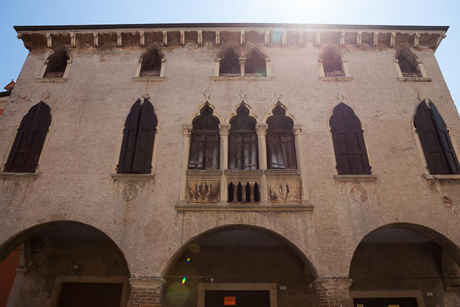
Palazzo Cavalli
If you look on your right then, you should be able to see the wonderful little church of Santa Maria dei Dominicani, or San Luigi or del Rosario, in lombard romanesque style with a beautiful rose window and a pensile prothyrum (with renaissance arch), even this one reporting Mary, Baby and the two Saints. The two windows on the facade and the short stair are less ancient.
The church was restored in 1985 thanks to the help of Banca Popolare di Verona. Inside we find three side chapels, one of these is dedicated to Saint Lucy and the other to Saint Apollonia. The church has been unvisitable until it was restored in 1992.
It was exactly during these restoring works, that a beautiful pictorial circle datable to the 15th century was discovered. It is clearly in the style of the working-class of that age and depicts stories about Saint Lazarus. Other frescos on the second altar are datable to the 500'. A smart and slim bell-tower completes the monument with the majesty of the standards depicting the effigies of Counts Cavalli, Captain Gradenigo and the Municipality, right on the top of the double-arched window of the bell cell.
Today the Church hosts important exhibitions and events, with a certain artistic and cultural depth. Annexed to the Church, there's a convent that now hosts the Public Library. For those who would like to learn more about this adventure in Soave, I advise the reading of a short but detailed leaflet that you can find for free either here in our farm, during your stay, or in the IAT office in Foro Boario Sqr.. In Piazza Antenna the main Palace is the Justice Palace.
A sweet stair drives you here to the groundfloor Lodge with four large pointed arches. The facade is made with bricks and stones, typically medieval with merlons and small romanic arches, headstones and decorations. It is impossible not to see the ancient and consumed latin inscription, just under the balcony, celebrating the end of the building works in 1375 by Cansignorio, during the period while Pietro Montagna was rector and captain of Soave.
This is what the translated lyric says:
"During the fifteenth lustrum of the year Onethousand and threehundred, in the period when paesants pressed their grapes with the feet, while Pietro from the Montagna family was praetor in this place, I was built, as a law-friend home; Cansignorio, master of the city, who holds your fate, o Verona, fortified these walls."
The so-called "verone" is sided by two windows and two 19th century headstones. One of them remembers Soave's jurisdiction above Caldiero, Belfiore, Arcole, Cazzano di Tramigna, Colognola ai Colli, Montecchia di Crosara, Monteforte d'Alpone, Roncą and San Bonifacio.
Other interesting palaces inside the borough, are Palazzo Pullici (now Pieropan), where Ippolito Nievo passed a period of his childhood; Palazzo Moscardo, in front of Pullici and Captain Palaces, was edified in the thirteenth century by the Scala family as domicile for the praetors. Since 1986 is the headquarter of the Municipal Hall.
INTERESTING MONUMENTS OUTSIDE THE WALLS
Just outside Porta Bassano a country road leads to the Bassanella Santum. From here the sight on the valley, with the glimpse on the Illasi Castle, is one of the most beautiful I've ever seen. Its original nucleus dates back to year 1000; during the year 1100 it was property of Saints Nazaro and Celso Benedictines and then, during the 15th century, the property passed to the Saint Giustina di Padova of the order of the Olivetani. After the falling of the Venetian Republic it passed to the Bishop of Verona. During the 19th century It took those neo-classical shapes that it shows today and in the same period the bell tower was also built. In the background of the santum rises the shape of the Castello Scaligero, a beautiful and impressive sight which remains fixed in the memories just like an amazing painting.
Near the Bassanella you can visit the little San Rocco's Church, dating back to 1400. In this Church two saints were venerated the Saints Rocco and Anna. The pine bell tower with double arched window is really evocative. The building is open on Mondays, but it is always better to ask the IAT office before visiting it to get updated info about the timetables.
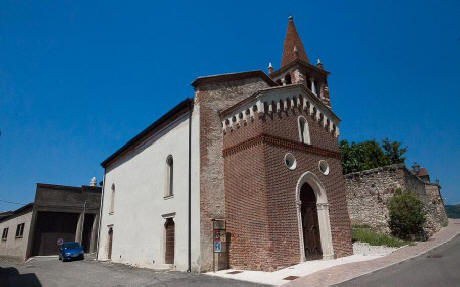
Saint Rocco's Church

Saint George's Church
In Borgo Covergnino we find the beautiful Saint George's Church, built maybe by the Franciscan Order in the 12th century. They had also a convent there. In 1600 it was a property of the Venetian Republic, which was forced to get it closed because of the war with the Turkish army. The little church was closed for a long while, then restored and later on reopened. It's full of many important and beautiful artworks; It's really worthwhile visiting.
Another curious thing to see is the prehistorycal animal's/cetaceus rib dangling above two ancient gravestones. Saint George's Church is important for its amazing devotional past. Passing through here on his way to France, PIO VII gave the plenary indulgence to everybody. And, upon this occasion, the Church was the only one with the privilege to host, in the first two days of August, the famous "Perdon d'Assisi". During this celebration the doors were especially kept open all night long to let the people walk around inside the temple and contemplate Saint Francis' sculpture holding two grapes of "ua luliega", a particular kind of white grapes which uses to grow untimely.
I also suggest you to visit Saint Anthony's Oratory and San Martino's Oratory and, if you feel like driving and walking through some very emotional routes and landscapes, you can reach the other little fractions around Soave, beautiful to see as well like: Fittą, Castelcerino, Costeggiola and Castelletto, all surrounded by vineyards.
The little Fittą is really fascinating. I advise the walk to the Vajo delle Anguane, passing through the Contrada Lelli. The Mysterious Caverns of the Anguane are located in the South-West of Castelcerino and the traditions say that some mythical female beings, with fantasy shapes, live in there. The curious fact is that the legend says that during the day it is impossible to see them, but, during the night, they come out from their caves just to go washing some clothes and spreading them out on the field, just in front of the laundry. Today it doesn't remain any tracks of them but this mistery is still very entangling for the locals. We can only imagine to hear their voice, coming out the Caverns, sounding like mermaids'.
Driving in the direction of Verona we can stop at the Terme di Giunone in Caldiero, our little country, land of ancient and noble roman thermal baths. You can have a thermal therapy bath in the roman pools Cavalla and Brentella, relax in the sun under the secular trees or have a swim in the pools.
CALEBRATIONS, OPEN-AIR MARKETS AND PERIODICAL EVENTS IN SOAVE
Soave is quite a little borough, but it differs from the others for the
accuracy and dynamism in planning and managing celebrations and events
focused on the valorization of its history, traditions, legends, grapes and
wines, art, cooking, gastronomy and landscapes.
The Pro-Loco group plans them in cooperation with important local
associations like the "Amici delle Antiche Torri".
The IAT office can always give you details about dates, time and place of
the events. For this you can also visit their site or the FB page.
The Festa dell'Uva is the most important celebration in Soave and it usually takes place on the 3rd Sunday of September; among the other events that make Soave always a dynamic place to enjoy, we have to remember: the "Festa dell'Imperial Castellania di Suavia"; the Soave's Carnival; the Fair of the Cattle and agricultural machines; the Medieval white wine Soave Fair; on the 10th of August, Saint Lorence Fair (He's the country Patron); the Castle Theatre, in Summer; the "Palio delle Contrade; the Autumn Meeting; the exposition of the traditional nativity scenes (even the living one); the Antique Trading (usually on the 3rd Sunday of every month) and the Week open-air Market of many goods (on Tuesdays); and, in the end, all the very interesting events organized in and by Borgo Rocca Sveva.
SOAVE'S WINES AND SWEETS
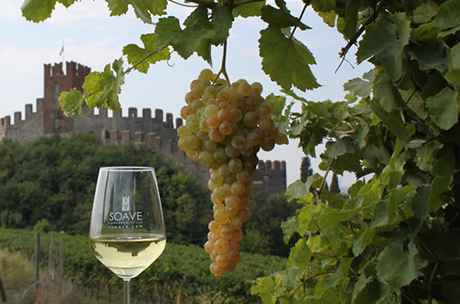
The White wine "Soave" is already known all over the world for its intense
and delicate perfume, its taste, full of harmony and with a little
bitterness, Classical or Superior, Doc or Recioto, that we can also find on
our markets as sparkling wine.
In the gastronomic sphere this wine is usually combined with soups,
foretastes and fish recipes or, also, just as an aperitif, served fresh.
Soave is a zone with an intense production of cakes and sweets. Delicious
sweets to enjoy with Recioto, an excellent dessert wine. Some of the local
most famous sweets are the Rufioi, the Sugoli, the Nadalin, the Favette, the
Brassadela and the typical Fugassa made with cotechino's lard.
You can find all these recipes on the Net, but also in many publications (titles in bibliography).
SOAVE AND ITS TERRITORY, POSSIBLE ITINERARIES
The hills around Soave are wonderful and always offer to their visitors the possibility to have beautiful and relaxing walks, rides (bike/horse) and drives.
There's a specific itinerary that I used to follow, walking for about an hour and a half along vineyards and capitals. You have to come out from Porta Bassano and follow the way that leads you to the Castle. After about 100 metres turn left and keep going until, walking on through the grapes, you find the quadrivium, named Pigno, a big pine tree that is also guardian to Vincenzo Ferreri's capital.
Saint Vincent Ferrer (Ferreri is the Italian version of the name) appears
quite often in the rural local paintings, protecting the hard work in the
fields. He is usually portraied with his index finger pointing at the sky
and a little flame above his head. He used to be prayed to avoid the
dryness, to protect the crops and to keep away all the atmospheric
calamities. From the Pigno a little way takes you down to the Ponsara little
valley, where you can find a copy of The Madonna della Bassanella (the
original is in the Sanctuary).
From the Ponsara, following the valley, we reach Piazza Scheeti, which gets
its name from the coat of nummulites dating back to 65.000.000 years ago.
Nummulite is a specif kind of sea fossile, looking just like a coin. In our
dialect, in fact, "scheo" means coin.
Walking South past the square, we pass besides an impracticable cave. We are in a little corner of Mount Tenda, a mount full of cypresses, pine trees and cornels. From the Cengele Capital you can also see the Mount Tondo. Going back to the borough we found a sort of fork which brings you to Castle, if you go right, otherways, if you choose to go left, you'll find a borough named Covergnino, just near Porta Vicentina. The walk to Saint George's Church starts right at the base of this borough.
Another wonderful and short itinerary through vineyards and cherry-trees, is the one which drives us to the other monuments and landscapes around Soave.
Coming out from Porta Bassano, keeping on going in the direction of
Costeggiola, we reach Colognola ai Colli, a small amazing town rising on a
hill, full of many suggestive palaces and churches. More than a way starting
from here will drive to Caldiero. Caldiero is an important crossway in the
East side of Verona, located strategically at the end of the Val d'Illasi,
between Verona and Vicenza. During the 10th century it was invaded by the
Hungarians, and, to defend the country, the locals built a defensive tower
on Monte Rocca. The tower got destroyed in a fire during the 13th century.
In Caldiero took also place the famous Napoleonic Battles during the years
between 1795 and 1813.
Caldiero is famous for its Terme di Giunone; their thermal waters seem to
come directly from the Val Fraselle. Today they're a sought-after important
touristic destination for wellness lovers, relax, and swimming lovers.
From Caldiero you can easily reach Belfiore, where it is possible to admire the fascinating romanic little Church of Madonna della Strą. Staying at what an ancient inscription, conserved in the Maffei Museum (Brą Square), says, the names of the builders of the Church are Ambrogio, Borgo and Malfato. Inside we can see a beautiful "Madonna Lignea" (named "della Strą"), placed upon a baroque altar. Coming back on the SR11 you could drive to San Bonifacio and visit the wonderful Villanova Abbey.
I would like now to spend a few words about the artworks inside this Abbey.
Our territory keeps in safety many treasures most of the people don't even
know the existence of. In the lower right part we can admire some Giotto's
school style frescos depicting scenes of Saint Benedict's life, and a copy
of the "Santa Francesca Romana by Guercino"; on the left, the Compassion
Altar, an important and prestigious work dating back to 1400 and created by
Egidio from Wienereustadt.
Driving over Soave in North direction, you reach the hills of Monteforte
d'Alpone, famous, with Soave, for the "crus" of the famous wine Soave. From
Castelcerino you can drive down to the Val Tramigna, a valley with a
complaisant weather, full of vineyards and olive trees. The cherrie's one is
absolutely the most eye-catching cultivation of the whole valley.
Let's proceed to Cazzano di Tramigna, the most important centre in this
valley, which has nothing less than a river flowing in its middle
contributing to make this country unique and suggestive. Here, in the centre
of a little olive cultivation, you can visit the little Church of San Pietro
in Briano.
The architecture of this Church is really linear and basic, but the things
that will really catch your eye, are the frescos, inside and outside it, all
dedicated to Saints and Mary. From the little San Briano's Church you can
also enjoy a beautiful sight of the Castle of Illasi. Once you pass Cazzano
you'll find a biforcation. Taking its left way, you'll find the next valley,
the Illasi one. Going on your way you'll discover the town of Campiano, a
very little village where Time seems to have stopped for a while.
It makes you feel like being inside a "Macchiaiolo" painter’s artwork, depicting a little piece of the traditional ancient Tuscany, and not the modern Veneto. Here two little typical Trattorie face each other in the main square and their special dish is the typical lamb meat with sauce. It is interesting to watch the old locals skinning and hanging on the walls the Ireos' roots ("gadois", they are a a king of ligh blue lily, which is possible to get perfumes from).
TYPICAL PRODUCTS OF SOAVE AND ITS TERRITORY, CELEBRATIONS AND OPEN-AIR MARKETS IN THE VALLEY
How not to talk about the products which make this place as famous as it
actually is in Italy?
The Classical Soave Doc wine and all the other various white, red, and sparkling wines produced by the many, private and not, farms in the Valleys. Each one of these has also got its specific main product apart from vineyards just like cherries, asparaguses, strawberries, apples, grapes, kiwis, olives and ireos.
We should also remember that the penultimate Sunday of February, in Caldiero, every year, takes place the famous San Mattia festival. Last year during this festival, a new delicious sweet was created. Its name is Brentella, just like the thermal pool in the Terme di Giunone, because this little cake is made with its thermal water. In Campiano, in August, remember the San Bernardo festival, and just before it, during the last week of July, the Ancient Saint Felice one.
SOAVE AND THE HORSES
Horse riding is sure the most adequate way to enjoy all the hidden beauties of Soave and East Verona countryside. I could tell you about some of the farms and stables which use to hire these beautiful animals for an afternoon ride, if you'd like to. To learn more about this opportunity you can ask Verona's Pre-Alps Trekking Centre or Lessinia's; otherwise you can also visit their specific web-sites.
I personally know and suggest the Riverside Club in Zevio, at a 5 minutes drive from our farm, a Sporting-Club which also organizes rides and riding lessons. I know the owner, he's a great and very willing person.
SOAVE FROM VAL D'ALPONE TO BOLCA
Once you leave Monteforte d'Alpone, keeping on going towards the valley
bottom, after a few kilometres you'll arrive to the little Roncą, famous for
its fossil molluscs museum, where you can admire many different species as
bivalvias and gastropods. In its close environs it's possible to see many
clear water poddles (home of some species of river shrimps) and the faded
volcano Monte Calvarina. Once you pass Montecchia Di Crosara, you'll be in
front of the basaltic San Giovanni Ilarione.
D'Alpone Valley ends in the Country of Vestenanova. The beautiful Parish
Church welcomes us with the huge mole of its ionic colonnade. Once you have
visited Vestenanova, you could drive to Bolca and its Mount Purga.
Two kilometres in North-East direction from here, we find the little
Pesciara, an extraction centre designated to fossil fishes and ittiolites,
dating back to the middle-lower Eocene (about 50.000.000 years ago). During
the 3rd Age, the area was covered by a not really deep sea, similar to the
tropical lagoons. Here the intense volcanic undersea activities and the
stagnant waters, helped the slow sedimentation, and so the perfect
conservation of the fishes. Here you should visit the Fossil Museum of
Bolca. It's very famous in the area for its ample collection of fossil
evidences. For the lovers of this world I’d also suggest a visit to the
Natural History Civic Museum in Verona city center near the river Adige in
the area denominated Veronetta.
To give to your trip a sweet ending, you should visit the Monastery in Badia Calavena (once, on Wednesdays, seat of a very nice fair with lots of livestocks and agricultural equipment) and the country of Cogollo, Berto's hometown; he was a steel artist whose tradition keeps living through the years thank to its son’s competence and passion for the art of iron working.
SOAVE AND THE FIVE VALLEYS
The east side of Verona, where our Farm-Holiday "I COSTANTI" is situated, is, just as we said before, a very suggestive region, full of hills, valleys, landscapes, castles and orchards lying against towers, boroughs and Venetian Villas. It's formed by five main valleys: Marcellise, Illasi, Mezzane, Tramigna, and Alpone.
Marcellise is the extreme West-limit of the Soave Doc production zone and
it's just a fraction of the biggest San Martino Buon Albergo, located just
before Verona. A few km after it and in direction of Soave, between Mezzane
di Sotto, Mezzane di Sopra and San Pietro di Lavagno, the beautiful Mezzane
valley, renowned for its excellent olive oil, twists its wonderful hills
along.
Starting from Colognola ai Colli, the Illasi valley lays on in Cellore direction, covering Illasi, San Zeno and Cellore, another limit of the Soave Doc production area. The valley goes on, then, covering Tregnago, Badia Calavena, Selva di Progno and Giazza. The Tramigna one is crossed by the same-named river, which flows through it, touching Cazzano and Soave. The Alpone Valley is the one which marks the border-line with the territory of Vicenza and includes Monteforte, Roncą, Montecchia and San Giovanni Ilarione. Driving in the direction of Vestenanova we’ll find Bolca and the Lessinia.
THE "SOAVE WINE-WAY" ON THE MAPS
As you read in the previous paragraphs, here at our farm or at the IAT
Centre in Foro Boario Square, you can ask for the map of the Soave Wine-Way,
edited by the Touring Club. It will tell you, in a very detailed way, all
you need to know about wine bars, hotels, restaurants, B&Bs, olive oil-mills
and bakeries, and also the names of all the businesses associating with the
Wine-Way.
Remember that Soave recently became a "books and culture" city, that's why a
lot of events about it will be soon organized, just like guided visits,
meetings with the authors, various books expositions, audio-readings and
musical happenings. For all the mountain-bike lovers, I also advice the
SOAVE BIKE, a run dedicated to mountain bike lovers.
So, if you'd like to see Soave, and lose yourselves in its magic landscapes, you could choose to stay here in our Castle/Farm-Holiday I Costanti, located only 3 kms far from Soave and its wonderful wineries.
THANKSGIVINGS:
I would like to thank Prof. Giuseppe Rama for its texts, which gave me, along with the people from Soave, all the knowledge that I needed to write this simple and passionate tale of mine.
BIBLIOGRAPHY:
- Soave ed il suo territorio ( G.Rama - Ed. Demetra);
- Il Soave, il territorio, i vini, i prodotti tipici e la cucina (Morganti Editori);
- Soave, Vino, Storia, Cultura, Tradizioni (Provincia di Verona e Touring Club Italiano).
Thanks to everybody but especially to you, tireless reader and guest of
mine, you that, for me, are an unlimited source of energy and joy.
With all my Love and dedication.
Francesca Vecchioni (text writer) for
I COSTANTI Farm Holiday Verona
February the 25th, 2017.
Translation made by Matteo Toccaceli
(for information about the translation service you can call 045-6151165)
I Costanti is a farm holidays in Veneto you’ll never forget.
For further information on prices and availability call Francesca:
(+39) 0456151165 (13:30-14:30) - (+39) 338.976.7854 (24h24)
©2017 Bed & Breakfast Agriturismo I Costanti - contatti: [email protected]